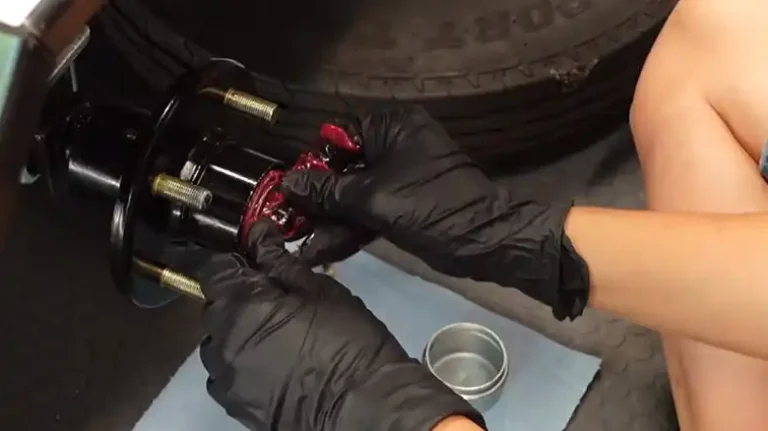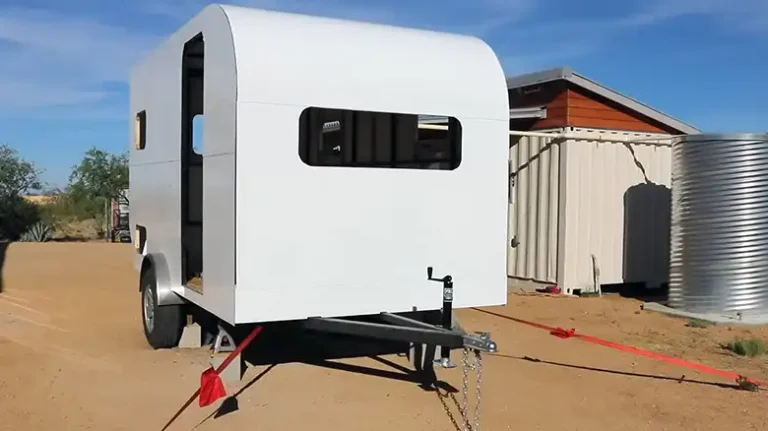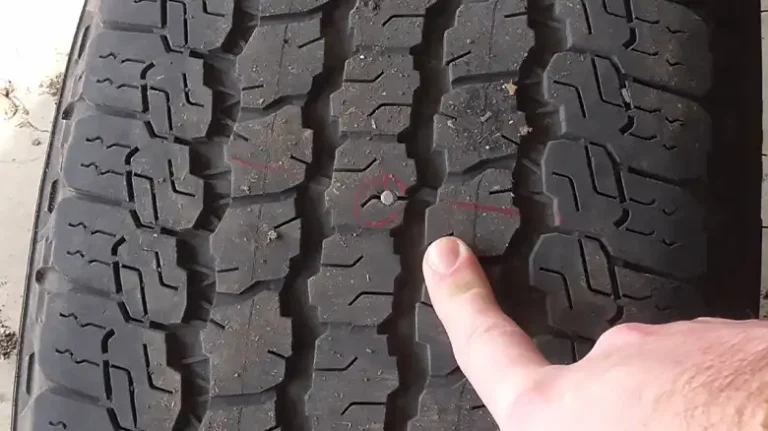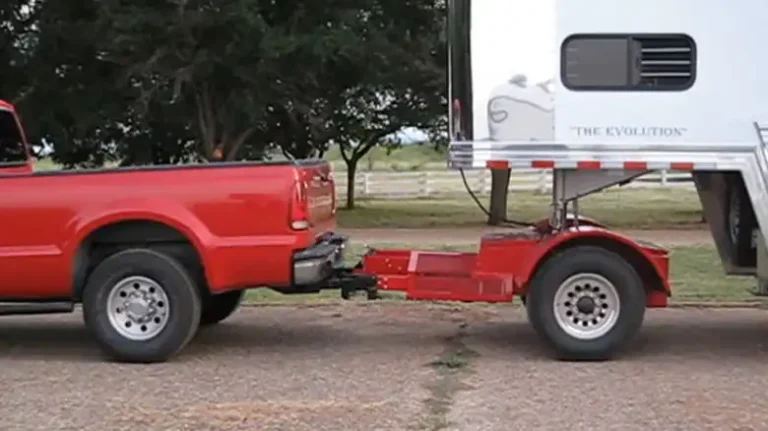Hauling a Golf Cart with a Fifth Wheel | Everything You Need to Know
Hitting the open road with a fifth wheel in tow is a dream come true for many travelers. The freedom to explore new places while bringing the comforts of home along is a compelling reason to embrace the RV lifestyle. But what if you want to take your golf cart with you on your adventures?
Maybe you’re parked at a stunning campsite, miles away from civilization, and you’re eager to explore the wilderness or golf course nearby. Your golf cart is your ticket to scenic trails or fairways, but it can’t drive itself. That’s where the magic of hauling comes in. Hauling a golf cart with your fifth wheel means you can indulge in outdoor adventures without leaving your trusted mode of transport behind.
Fear not, fellow traveler, as this comprehensive guide will walk you through the ins and outs of hauling a golf cart with a fifth wheel. Just take a few minutes and keep reading the article without skipping any part.
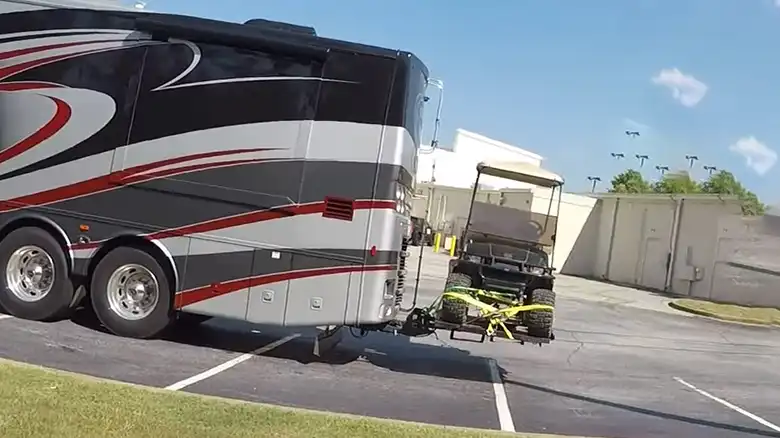
Assessing Your Fifth Wheel and Golf Cart
Evaluating Your Fifth Wheel’s Towing Capacity
When it comes to hauling a golf cart with your fifth wheel, the first and most critical step is to evaluate your fifth wheel’s towing capacity. This capacity determines how much weight your RV can safely tow without compromising safety and performance. Exceeding your fifth wheel’s towing capacity can lead to hazardous situations on the road.
To determine your fifth wheel’s towing capacity, you’ll typically find this information in your RV’s owner’s manual or on a label near the driver’s side door. Pay close attention to the Gross Vehicle Weight Rating (GVWR) and the Gross Combined Weight Rating (GCWR) listed. The GVWR is the maximum weight your fifth wheel can safely weigh when loaded with all your belongings, while the GCWR includes the combined weight of both your fifth wheel and the towed golf cart.
Ensure you have your fifth wheel weighed with all your belongings in it, as well as any passengers or pets who will be traveling with you. Subtract this loaded weight from the GVWR to determine how much weight you can safely tow.
Understanding the Weight and Dimensions of Your Golf Cart
Golf carts, while seemingly compact, can vary significantly in weight and size. Typically, a standard golf cart weighs between 900 to 1,200 pounds. However, custom models and accessories can increase this weight.
Understanding the specific dimensions and weight of your golf cart is essential for selecting the right trailer and ensuring your fifth wheel can handle the load. Measure the length, width, and height of your golf cart, including any added features or attachments like roof enclosures or utility beds.
Additionally, you should weigh your golf cart using a scale to get an accurate figure. This weight is crucial in calculating the overall load you’ll be towing. Keep in mind that golf cart weights can vary, so having an exact measurement is key.
Essential Equipment and Accessories
Selecting the Proper Trailer Hitch and Coupler
The hitch you select is the crucial connection point between your fifth wheel and the golf cart trailer. Choosing the right hitch ensures both safety and stability during your journey. Here are some common types of hitches –
- Fifth Wheel Hitch: This is the most common type for RVs. It connects directly to the bed of your truck, offering stability and a high towing capacity.
- Gooseneck Hitch: Similar to the fifth wheel hitch, the gooseneck hitch connects to the bed of your truck, but it’s a good option if you have a short truck bed. It provides a strong connection, but your truck must be equipped to handle it.
- Bumper-Pull Hitch: Also known as a ball hitch, this type is commonly used for lighter loads and smaller trailers. It connects to the bumper or frame of your fifth wheel.
Hitches come with weight ratings. Make sure your hitch is rated to handle the combined weight of your fifth wheel and the golf cart. It’s wise to choose a hitch with a rating that exceeds your total load for safety and it’s recommended to have a professional install your hitch to ensure it’s securely fastened to your tow vehicle.
The coupler on your golf cart trailer connects to the hitch. It should match the size and type of hitch you’re using, whether it’s a kingpin (for fifth wheels) or a gooseneck coupler.
Safety Chains and Brake Controllers: Must-Have Accessories
Safety is a top priority when hauling a golf cart. Here’s what you need –
Safety Chains:
- Safety chains are crucial. In the event of a hitch failure, they provide an additional connection between the trailer and the tow vehicle.
- Cross the safety chains beneath the trailer’s tongue to form an ‘X.’ This setup prevents the tongue from dropping to the road in case of a hitch failure.
Brake Controllers:
- Brake controllers are essential for trailers with brakes, including most golf cart trailers.
- They allow you to control and monitor the brakes on your trailer, improving safety and braking performance.
- Ensure the brake controller is adjusted correctly to prevent excessive or insufficient braking.
Tying Down and Securing the Golf Cart
Now that your hitch and coupler are in place, securing the golf cart to the trailer is paramount –
1. Straps and Tie-Downs:
- Use high-quality straps and tie-downs to secure the golf cart to the trailer.
- Cross the straps over the golf cart to create an ‘X’ pattern, distributing the tension evenly.
2. Wheel Chocks:
- Place wheel chocks behind the golf cart’s wheels to prevent it from moving during transit.
- Ensure the chocks are snug against the tires and properly secured.
3. Additional Supports:
- Some users prefer using additional supports, such as wheel stabilizers or braces, to further prevent movement during travel.
- Check your golf cart’s manual for manufacturer-recommended methods.
4. Inspect Regularly:
- Periodically check the straps, tie-downs, and wheel chocks during your journey to make sure everything remains secure.
Properly tying down and securing your golf cart is a vital step to prevent accidents and damage to your equipment, and ensuring a smooth, worry-free journey.
Loading and Unloading Your Golf Cart
Proper Techniques for Loading the Golf Cart onto the Trailer
Step 1: Prepare the Golf Cart
Before you begin loading, ensure your golf cart is in prime condition. Check the tire pressure, brakes, and any loose or detachable components. It’s also a good practice to secure any loose items on the cart, like golf bags, to prevent them from falling during the loading process.
Step 2: Position the Trailer
Your fifth-wheel trailer should be on level ground and properly choked to prevent unwanted movement. Ensure that the trailer is securely attached to the towing vehicle, and the hitch is ready for the load.
Step 3: Align the Golf Cart
Position your golf cart in front of the trailer’s loading ramp, ensuring that it’s perfectly aligned with the ramp’s width. You might need a spotter to guide you during this step, especially if you’re new to hauling a golf cart.
Step 4: Gradual Ascension
With the golf cart aligned with the ramp, drive it slowly and steadily up the ramp. It’s crucial to maintain a consistent speed and avoid sudden accelerations. Make sure the golf cart’s wheels stay centered on the ramp during the ascent.
Step 5: Secure the Golf Cart
Once the golf cart is on the trailer, secure it with tie-down straps, chocks, or any other suitable means. These restraints will prevent any movement during transit. Make sure the straps are tight, but not overly so, to avoid damaging the cart.
Safely Unloading Your Golf Cart at Your Destination
Step 1: Park and Prepare
After reaching your destination, park your fifth wheel on level ground, and chock the wheels to ensure stability. Turn off the engine and set the parking brake. Remember to be cautious when you’re near traffic or in busy areas.
Step 2: Unloading Setup
Now, it’s time to get your golf cart ready for unloading. Remove all the restraints, such as tie-down straps or chocks, that were used to secure the cart during transit. Ensure the golf cart’s ignition is turned off.
Step 3: Descending the Ramp
Position the trailer’s ramp for the descent, ensuring it’s at a gentle angle for a smooth unloading process. Drive your golf cart slowly down the ramp, maintaining control and using the brakes as needed. A spotter can be invaluable here to guide you and ensure a safe descent.
Step 4: Final Checks
Once the golf cart is safely on the ground, conduct a thorough inspection to ensure nothing is damaged during transit. Check the tires, undercarriage, and any other susceptible parts. It’s a good practice to inspect the trailer for any potential issues as well.
Step 5: Secure Your Fifth Wheel
With the golf cart unloaded, ensure that your fifth wheel is securely parked and choked before heading off on your adventures. This step is essential to avoid any unintentional movement while you’re away from the vehicle.
Tips for a Smooth Loading and Unloading Process
- Practice Makes Perfect: If you’re new to this process, practice loading and unloading your golf cart in a controlled environment before hitting the road. Familiarity with the steps can greatly enhance your confidence.
- Buddy System: Having a spotter to assist you during loading and unloading can make the process safer and more efficient.
- Maintain Balance: Ensure that the golf cart’s weight is distributed evenly on the trailer to prevent any tilting or swaying during transit.
- Check the Battery: Before loading your electric golf cart, make sure the battery is fully charged. This ensures that it can be driven onto and off the trailer smoothly.
- Use High-Quality Straps: Invest in quality tie-down straps or wheel chocks to secure your golf cart effectively. These will provide peace of mind during your journey.
Towing Laws and Regulations
Familiarizing Yourself with Towing Laws in Your Area
Before you hit the road with your fifth wheel and hauled golf cart, it’s crucial to understand and comply with towing laws and regulations. These laws are not only in place to ensure your safety but also to maintain the safety of others on the road. Towing laws can vary from state to state, and in some cases, even between different municipalities. So, it’s essential to familiarize yourself with the laws specific to your area. Let’s explore some key aspects –
Weight and Length Limits
Different jurisdictions have specific weight limits for trailers, including fifth wheels and the cargo they carry. The Gross Vehicle Weight Rating (GVWR) of your fifth wheel and the weight of your hauled golf cart should not exceed these limits. Additionally, there may be restrictions on the total length of your fifth wheel and trailer combination. Exceeding these limits can result in fines and penalties.
Pro Tip: Always check your state’s Department of Transportation or local authorities’ websites for the latest regulations. They often provide comprehensive guides on towing laws and regulations.
Trailer Hitch Regulations
Your trailer hitch must meet specific safety standards, and its size and weight-carrying capacity should match your fifth wheel’s towing requirements. The ball size, receiver size, and safety chain connections must comply with state regulations. Always ensure that your hitch is properly installed and maintained.
Brake Requirements
In many states, trailers over a certain weight threshold are required to have brakes. This means your hauled golf cart trailer may need its own braking system. Some jurisdictions also mandate a breakaway brake system, which activates the trailer’s brakes if it becomes disconnected from the towing vehicle.
Pro Tip: Even if it’s not required by law, having a good braking system for your hauled golf cart is a safety-conscious decision.
Lighting and Reflectors
Proper lighting is a fundamental aspect of road safety. Your fifth-wheel and hauled golf cart should have functioning brake lights, taillights, turn signals, and reflectors. Ensure that your lights are visible, clean, and in good working condition to avoid accidents and potential legal issues.
Speed Limits
When towing a trailer, you might be subject to reduced speed limits. These limits vary from state to state and are often lower than regular speed limits. Always obey posted speed limits and drive at a safe and appropriate speed for your setup.
Licensing and Endorsements
In some places, you might need a special driver’s license or endorsement to operate a fifth-wheel and hauled golf cart, especially if it exceeds certain weight thresholds. Ensure you have the correct license or endorsement to avoid legal complications.
Pro Tip: If you’re unsure about your licensing requirements, contact your local Department of Motor Vehicles for guidance.
Staying Compliant: Trailer Lights and Safety Requirements
Besides the general towing laws, there are specific requirements related to your trailer’s lights and safety measures that you must adhere to for a safe and legal journey:
Lighting Requirements
Your fifth wheel and hauled golf cart should have proper lighting. This includes brake lights, taillights, turn signals, and license plate lights. They must be fully functional and clearly visible, even when driving at night.
Safety Chains
Safety chains are your last line of defense if the trailer becomes detached from your towing vehicle. They are not only essential for safety but also a legal requirement in most places. Ensure they are properly connected and in good condition.
Trailer Mirrors
To have a clear view of your fifth wheel and hauled golf cart, you may need extended or additional mirrors. These are often mandated by law to ensure safe towing.
Weight Distribution Systems
In some areas, using a weight distribution system is a requirement when towing heavy loads. This system helps distribute the weight more evenly across the axles, enhancing stability and control.
Insurance Considerations for Hauling a Golf Cart
You can’t hit the road without proper insurance coverage. When you’re hauling a golf cart with your fifth wheel, it’s essential to understand your insurance needs. While the specific requirements may vary, here are some general considerations –
Liability Insurance
This is a must-have and covers you if you’re at fault in an accident. Make sure your policy provides adequate coverage for both your fifth wheel and the hauled golf cart.
Comprehensive and Collision Coverage
To protect your fifth wheel and the hauled golf cart from damage due to accidents, theft, or natural disasters, consider comprehensive and collision coverage.
Specialized Coverage
Some insurance providers offer specialized policies for RVs and their unique requirements. These can cover additional aspects like roadside assistance and personal belongings in your fifth wheel.
Pro Tip: It’s a good idea to contact your insurance provider to discuss your specific situation and ensure you have the right coverage for your fifth wheel and hauled golf cart setup.
Planning Your Route and Trip
Mapping Out Your Journey: Routes Suitable for Fifth Wheel Towing
1. Know Your Vehicle’s Dimensions: Before you hit the road, familiarize yourself with the exact dimensions of your fifth wheel, including its height, width, and length. This knowledge is essential for choosing routes that accommodate your rig. Also, measure the dimensions of your golf cart on the trailer.
2. GPS Navigation Systems: Invest in a GPS navigation system designed for RVs and trailers. These devices take into account your rig’s size and weight, helping you avoid low bridges, narrow roads, and other obstacles. Apps like RV-specific GPS and Google Maps with RV mode can be invaluable.
3. Online Resources: Utilize online resources and forums where experienced RVers share route recommendations and tips. Websites like RV Trip Wizard and AllStays can help you plan RV-friendly routes and locate campgrounds.
4. Plan Your Stops: Plan your pit stops strategically. Look for rest areas and truck stops with ample parking space for your fifth wheel. Many states offer rest areas equipped for RVers.
5. Scenic Routes: If you’re looking for picturesque routes, consider scenic byways and highways. Keep in mind that these routes might have more challenging terrain, so be prepared for steep grades and sharp turns.
Pit Stops and Rest Areas: Where to Park and Refuel
1. Rest Areas: Rest areas are a great place to take a break, stretch your legs, and use the facilities. When stopping at rest areas, look for separate RV and trailer parking spaces to ensure you have enough room.
2. Truck Stops: Truck stops are equipped for large vehicles, including RVs and fifth wheels. They offer services like fueling stations, convenience stores, and sometimes even restaurants. Plan your route to include truck stops for fueling and rest.
3. Campgrounds: Many campgrounds cater to RVers and offer overnight stays. It’s a great idea to book campgrounds along your route in advance. This way, you’re guaranteed a safe and comfortable place to park for the night.
4. Fueling: When refueling, choose gas stations and truck stops with ample space for maneuvering. Plan your fuel stops strategically to avoid tight corners and low overhangs.
Be Prepared: Emergency Planning and Tools for the Road
1. Emergency Kit: Always carry an emergency kit that includes items like a flashlight, basic tools, first-aid supplies, and emergency flares. In case of unexpected breakdowns or accidents, you’ll be prepared.
2. Spare Parts: Carry spare fuses, belts, and other critical parts that might need replacement during the trip. This can save you from being stranded.
3. Communication: Have a reliable means of communication, such as a cell phone, two-way radio, or a satellite phone. It’s essential to stay connected in case of emergencies or when you’re out of cell service range.
4. Roadside Assistance: Consider enrolling in a roadside assistance program specifically tailored for RVers. These services can provide help with towing, tire changes, and more.
5. Safety Gear: Ensure you have safety gear like reflective vests and warning triangles to use in case you need to pull over on the side of the road.
Driving Safely with a Hauled Golf Cart
Driving safely with a hauled golf cart is a critical aspect of your journey. It not only ensures your safety but also the safety of others on the road. Hauling a golf cart behind your fifth wheel presents some unique challenges and considerations. Here, we’ll discuss detailed and authentic information to help you navigate the road with confidence.
Handling Challenges: Navigating Turns and Narrow Roads
1. Turning with a Hauled Golf Cart
When navigating turns with a hauled golf cart, you must account for the extended length of your fifth-wheel setup. Here’s how to handle it –
- Wider Turns: Make wider turns than you would with just your towing vehicle. This prevents the risk of the golf cart clipping curbs or obstacles.
- Use Your Mirrors: Rely on your side mirrors and consider adding extended mirrors to see the full scope of your setup.
- Plan Your Approach: Plan your turns well in advance and signal early to alert other drivers of your intentions.
2. Maneuvering Through Narrow Roads
Narrow roads can be intimidating, but with the right approach, you can navigate them safely –
- Scout Ahead: If possible, have someone scout ahead and inform you about oncoming traffic or tight spots.
- Slow and Steady: Reduce your speed and take your time. There’s no rush when safety is on the line.
- Stay Centered: Keep your fifth wheel and golf cart as centered as possible within your lane.
Maintaining a Safe Speed and Distance
1. Safe Speed
Maintaining a safe speed while hauling a golf cart is crucial. Consider the following –
- Speed Limits: Always adhere to posted speed limits and consider driving slightly below them for added safety.
- Downhill Caution: Going downhill, especially on winding roads, can be challenging. Engage your engine brake or trailer brake controller to maintain control.
- Uphill Challenges: When ascending steep inclines, shift to lower gears to prevent your engine from overheating.
2. Following Distance
Maintaining a safe following distance is essential to avoid accidents. Here’s how to do it –
- The Four-Second Rule: Keep at least a four-second gap between your vehicle and the one in front of you. This gap allows you enough time to react if the lead vehicle suddenly stops.
- Increase in Bad Weather: In adverse weather conditions, such as rain or snow, increase your following distance to at least six seconds.
Monitoring the Trailer and Golf Cart While Driving
To ensure the safety of your setup and those on the road with you, you must continuously monitor your trailer and golf cart. Here’s how –
- Regular Check-Ins: Frequently check your mirrors to ensure that the trailer and golf cart are tracking smoothly.
- Tire Pressure: Maintain proper tire pressure in both your fifth wheel and the golf cart to enhance stability.
- Brake Controller: Keep an eye on the brake controller to ensure the trailer brakes are working correctly. Adjust the settings as needed, especially on steep descents.
- Weight Distribution: Ensure the weight of the golf cart is properly distributed to prevent sway and ensure better handling.
- Wind Conditions: Be extra cautious in windy conditions, as crosswinds can affect your rig’s stability. Reduce your speed and maintain a firm grip on the steering wheel.
Wrapping It Up
Congratulations, fellow traveler, you’ve reached the end of our comprehensive guide on hauling a golf cart with a fifth wheel. Now, it’s time to celebrate the beginning of your adventure. As you hit the road with your fifth wheel and golf cart in tow, remember that the journey itself is the ultimate reward. Embrace the freedom and the unforgettable moments that lie ahead. If you ever have questions or need further guidance, feel free to leave a comment in the section below. Safe travels, and may your golf cart adventures be filled with joy and excitement!

